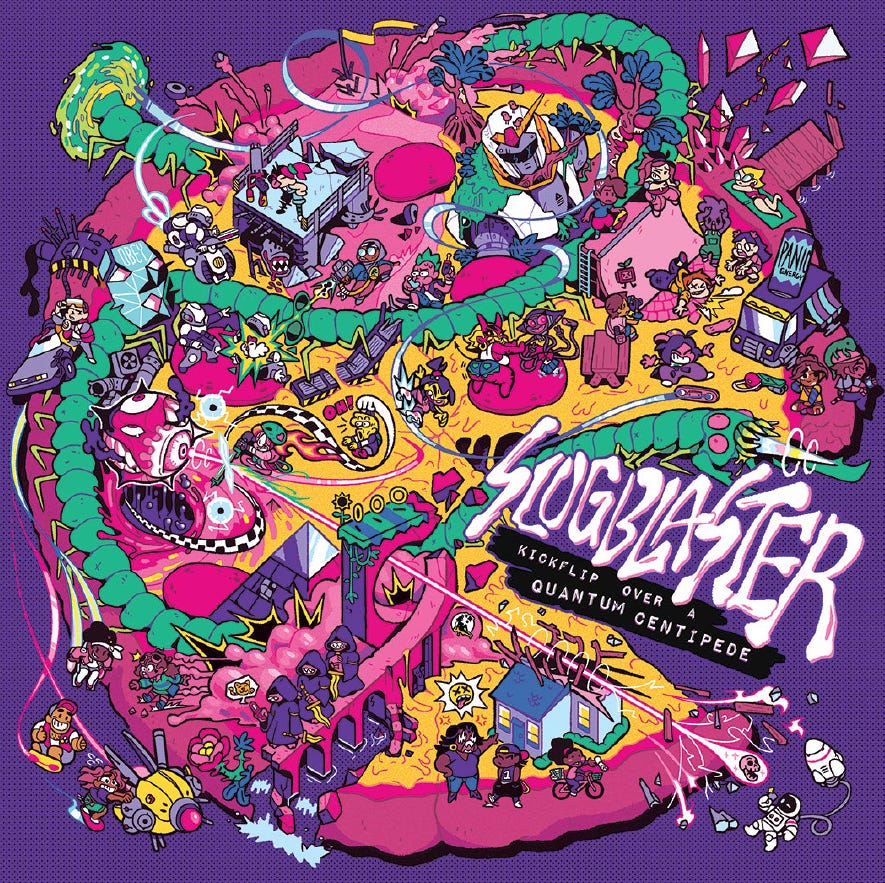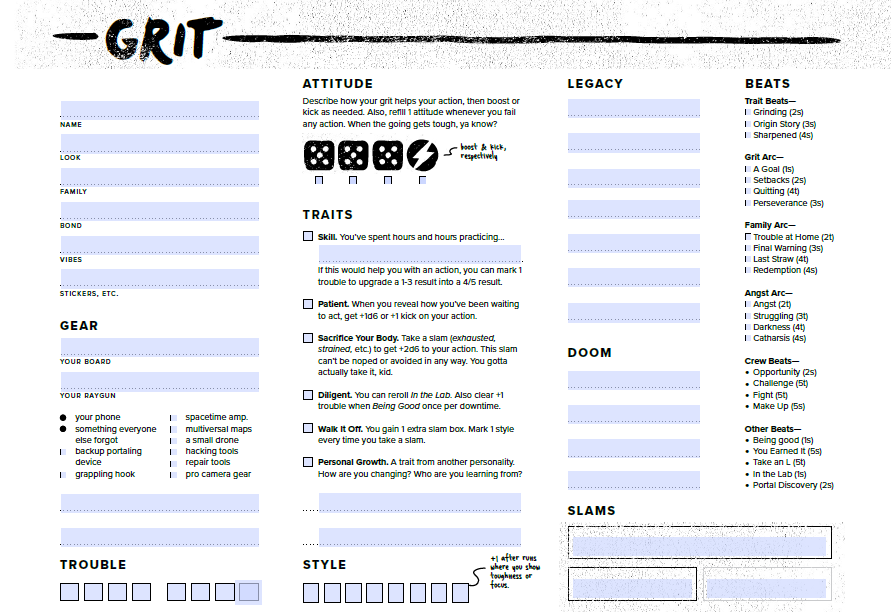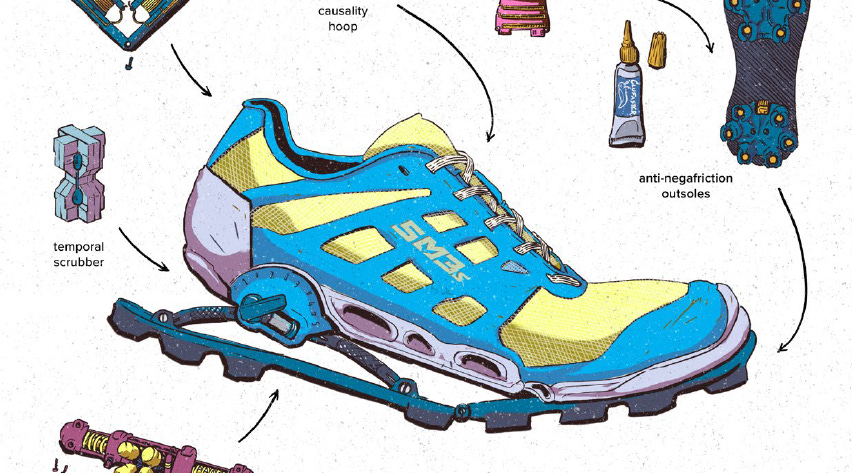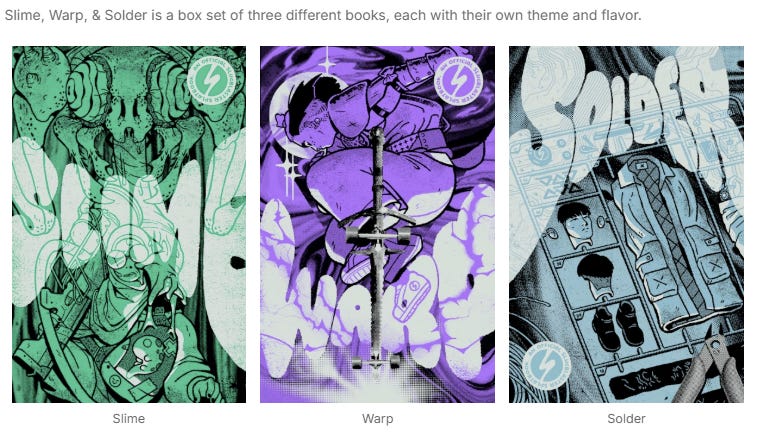From Circuit Bending to Reality Bending: The DIY Roots of Slugblaster's Interdimensional Skateboarding
Let's find out how Mikey Hamm obsessively crafted Slugblaster through relentless collaboration
Back the expansion to Slugblaster on Backerkit, Slime, Warp and Solder.
Inspiration
Hi Mikey, can you introduce yourself and tell us about your connection to tabletop RPGs?
I'm Mikey! I live in Edmonton (in Canada) with my wife Stephanie and our two kids. I'm a support worker by day and a game-designer by early morning. I'm the creator of Slugblaster!
Alright, let's talk Slugblaster. How would you describe the game to people who haven't heard of it?
You're teenage skateboarders sneaking into other dimensions for the same reasons teenagers have always snuck into places—to explore, have fun, get in trouble, and prove your cool.
The game seems to draw inspiration from many sources - skateboarding culture, science fiction, coming-of-age stories, etc. But especially skateboarding culture. What drew you to that particular activity as the underlying metaphor for slugblasting?
It's teenage risk-taking at its purest form. This is an adventure game where you're going to fire dimensions and running from packs of metasaurs and so by spotlighting skate culture it reminds us that this is the kind of stuff that teenagers might actually do given the chance.
The gear and mods you can throw together seem like a fun part of the book at first, but the mods go on and on, and after a while one realizes that this is a deep aspect of the potential play experience. What were your inspirations for all that fun science fiction gear?
Yeah, they were fun! I like reading physics. I don't understand most of it, but I like the cool words. Often I would pick a physics concept (ex: light) and base a signature around it (ex: the hardlight board) then just push that concept as far as I could until by the end you're able to, you know, turn into light yourself.
I like to design locations like playgrounds and gear like toys. I try to imagine that character in a variety of classic slugblaster situations (fight, party, chase, exploration) and see if I can imagine at least a few uses for their device in those situations. I don't need (or want!) to think of everything someone could do with it, I just want to make sure I feel the potential.
The list of inspirations that you include at the beginning of the book really run the gamut. It's a lot of pop culture film and TV. But did music play any part in inspiring you when writing and developing the game?
Yes, definitely, especially in the early playtests when I was still trying to figure out what the tone and specific genre of this game actually was.
But more so than that what inspired me was actually my time as a musician myself in my early 20s. Slugblasters are into DIY gear and that's inspired by the DIY indie scene that I was a part of—circuit bending, chiptune, crazy guitar pedals and rebuilt synths and stuff. So when I'm 24 and in my bedroom soldering an arcade button onto a toy keyboard, I'm daydreaming about a kid soldering an arcade button onto a photon gun.
Tackling multiverses in an RPG can be a daunting task, considering there are infinite possibilities. How did you settle on succinctly described and distinct one-page worlds?
In an infinite multiverse (or just on the internet) it's easy to get overwhelmed. It's important to zoom out sometimes and remember our insignificance, but it's also important to zoom in too. To focus on your immediate world. Slugblaster exists in an infinite multiverse, but the kids have learned to only care about the dozen or so nearby worlds they can actually reach. That gives players a tangible sandbox to play in, and let me write a bunch of fun video game levels tailored to Slugblaster's needs—each one is a skatepark in disguise.
Design
Slugblaster is based on John Harper's Blades in the Dark rules paradigm. What drew you in particular to that ruleset?
It was actually pretty superficial things like crew sheets and factions! Stuff that's so fun but not the kind of core gameplay I should have been considering when picking a system. Luckily, Blades core mechanics are great for cinematic action, so I got lucky!
The concept of "Style" as both a mechanical resource and a thematic element is central to the game. What led you to make this the core currency of player advancement?
Dave, I'm gonna be honest. I have no idea. Style (originally called "cool points" I think?) existed since my second (of 3) attempts at designing Slugblaster, but it has changed more than any other element of my game except for maybe slams. I knew early on that you could buy fame and sponsorships with it, but it wasn't until the late stages of development that I designed the beat system and style became more representative of self-actualization (xp) than a measure of how cool people think you are.

The "Noping" mechanic creates this fascinating moment where teenagers essentially say "Nope, not today!" to the universe. It feels like a perfect mechanical expression of teenage invulnerability and plot armor. How did this mechanic evolve during development, and were there any surprising ways you've seen players use it at the table?
The resistance mechanic from Blades in the Dark was so good at showing competent scrappy characters. I just took it and made it a little simpler and more overtly tied to luck rather than stress. Blades characters are wrestling through problems, Slugblasters seem weave around them. And yeah! There's been some really fun moments (Chill characters reaching down to tie their shoes and unknowingly avoiding a laser), but the thing that surprised me is how often people chose not to nope. It's fun getting slammed, ya know?
Signature devices are central to both character identity and gameplay in Slugblaster - from reality cannons to photonic jackets. Each feels mechanically distinct while maintaining thematic cohesion. Were there any devices that particularly challenged your design sensibilities?
Yes, absolutely. The Skipmode runners are a great example because they deal with time and time travel in a role-playing game is always tricky. Unspending resources, etc. So I tried to focus more on abilities that go forward in time (which is a little more straightforward) but I still put in one ability that lets you rewind a few seconds and, sure thing, I probably rewrote that ability 10 or 12 times.
Tone and Theme
You've created a nuanced portrayal of teenage life alongside interdimensional adventure. The arcs about family tension, identity struggles, and social dynamics feel deeply authentic despite the fantastical setting. How can a GM ensure that these emotional elements remain grounded and resonant even when the characters are doing gravity-defying hoverboard tricks through quantum dimensions?
The weird thing I've discovered is that it works the other way around—grounding the game doesn't allow sincere moments as much as sincere moments ground the game. Verisimilitude comes from our emotion and senses. Sure you can have someone with sneakers that turn them incorporeal, but if you take a few moments to describe the feeling of the cold concrete as they pass through it or the whispered argument between their parents they overhear while sneaking in then suddenly it feels like something that we've experienced, even though we never will never walk through walls.
Slugblaster's faction system creates a rich social landscape where crews navigate relationships with sponsors, authorities, and different crowd demographics, all with mechanical consequences. What kind of gameplay atmosphere were you hoping to create here?
I want to create hard decisions. I want people to have to navigate these this web of teenage politics (MxPx reference?) and have to make compromises and mistakes and navigate gray areas and have to hide their relationship with one faction from another faction who doesn't like that first faction. Hijinx!
I also try to write each faction with pros and cons. The sell-outs are really nice. The indie skate shop is run by assholes. The big tech company has a good scholarship program. Its more interesting and in many cases more reflective of reality.
The epilogue system is particularly poignant, allowing characters' stories to extend beyond the campaign. What were you hoping players would experience through this reflection on their characters' futures?
There is something special about playing a child, I think. A parental instinct kicks in or something and you find yourself really caring about these characters more than usual. Taking time to explore what happens as they grow up gives closure and makes you say goodbye. Kids need to grow up. It's not always what you want, but it is what your character wants.
Many of the worlds and problems in the game seem to metaphorically reflect teenage feelings of alienation, discovery, and risk-taking. Have you ever been surprised or impressed by what players come up with in this department? Have there ever been tears shed at the table?
Yes. Far more often than a game with psionic crocodiles deserves.
Miscellaneous
Slugblaster has a distinctive visual and narrative voice that feels cohesive throughout. However did you find the amazing artists who contributed to the book?
Just a whole lotta random chance! I had a style of art in mind for Slugblaster from day 1, and so if I was at a convention or scrolling instagram and saw art that fit that style I would jump on it. Most of the artists are either locals, friends of mine, or both.

How did you work with your artists and collaborators to create this unified vision? There's no detail too small here- I'm intensely curious about how Slugblaster got made.
So many emails. SO many. I would send a big mood board to the artists trying to convey my vision—a 90s MTV Logo with colors I liked, a frame from Back to the Future 2 showing the underside of Marty's hoverboard, etc. Then there would be a lot of back and forth. Especially with my first artist, Scott A. Ford. That poor guy. I must have sent him 100 emails in those early days, as I tried to hone the vision. I learned to let go more overtime, I hope.
You've created a game that's really rooted in nostalgia of the 80s to maybe early 00s. How do you hope Slugblaster is received by younger audiences who might not have as much of a grasp on those decades of yore when things like skateboarding was kind of a big deal?
Oh I really just hope they think I'm cool and not a 39-year-old having a mid-life crisis. But beyond that I hope they make it their own, enjoying the fantasy of playing in the prehistoric 90s or exploring their own nostalgia for the 2010s and coming up with new takes on slugblasting I couldn't imagine. Maybe I was able to touch on something timeless about teenagehood they'll connect with, maybe I made a time capsule. I'm okay with either.
The Factions and Sponsors at the end of the book really seem to breathe life into a setting and make the whole game feel ripe for adaptation to a graphic novel, TV series or other media. What would be your dream adaptation for Slugblaster?
Dream scenario is an animated series by the Spider-Verse team. They would nail the tone. Next choice would be a graphic novel for sure.
Quintin Smith of board game review fame broke into the RPG review space and quickly became the most popular and beloved RPG reviewer on the platform. And every time he releases a review, sales of that game shoot into the stratosphere. I assume this happened with Slugblaster after he reviewed it on his channel. Can you describe what it was like to have Slugblaster experience that surge of attention and popularity?
Oh it's been a TRIP. In those first couple weeks I'm just so grateful. I hope Quinns' success spawns more reviewers like him, because there are so many games people need to know about.
What is next for Slugblaster?
An expansion! It's called Slime, Warp, & Solder and I think people are going to enjoy it as much as we're enjoying making it.
More on Slime, Warp and Solder:
SLIME
SLIME is all about bugs, gunk, and xenobiology. If you like your Slugblaster sessions slippery and mutated, this one is for you.
New biological signatures like Creature Pet and Monster Genes.
More monsters, like the battery-draining Plasmolid and the infamous Party Roaches.
Rules for playing as ultra-terrestrial characters!
The Slime Table! Let the dice decide what you just got splattered with and why it's making your skin turn purple.
"Rescuing Rescue", a pulpy pre-written scenerio to dump on your players.
And more!
WARP
WARP is a mind-bending dream silo of psionics, omega tunnels, and esoteric sciences. For those who like their sessions weird and trippy.
New arcane signatures, like Telepathic Potential and Alt-Channeling.
More monsters, like the Axiom soliton or the mysterious Waking Pits Vampire.
The Dreaded Peelback Table.
"Logic Mirage", a mind-bending scenario to warp your whole campaign.
And more!
SOLDER
SOLDER is about servos and lasers, drift fields and velocity bias. For those who want their sessions overclocked and cranked to 11.
A storage locker full of new signature devices like Laser Blades or the Jailbroken Miper Phone.
More monsters! War bots, gravity storms, the Quadratic Giga Chad, and more!
Three huge Loot Drop tables, each filled with exciting and strange salvage.
"Breaking DARA", a thrilling heist scenario ready to go completely off the rails.
And more!
Click here to find out more about the Slugblaster expansion on Backerkit!












